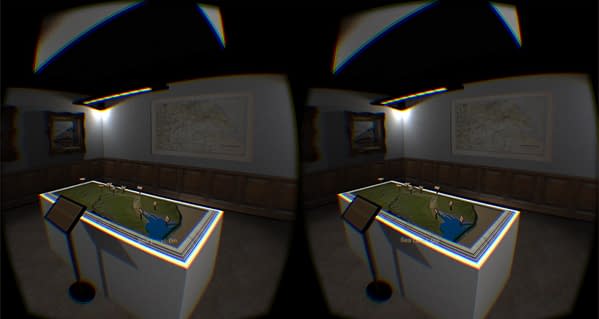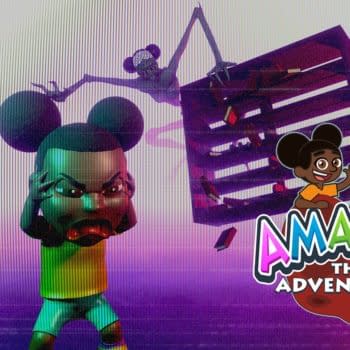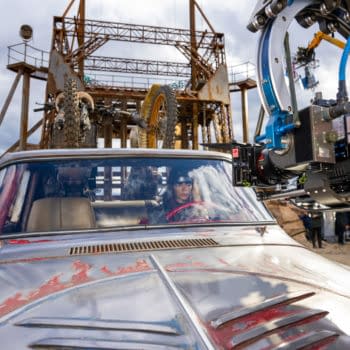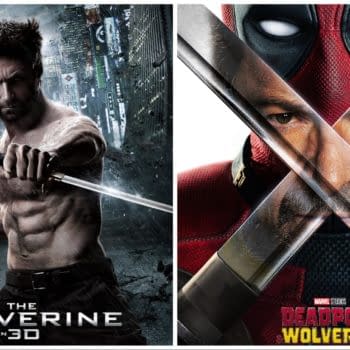Posted in: Games, Movies, Video Games | Tagged: Dr. Chris Skinner, entertainment, gaming, Humber in a Box, industrial technology, Oculus Rift, video games
The Humber In A Box Project – Industry Applications For Gaming Tools
By Phil Harris
As gaming develops the technology developed to help create better and more believable worlds and settings advances and whilst some of this technology, like the Occulus Rift, may be in its infancy, the applications it can be used for are staggering.
In the past industry turned a blind eye to gaming developments but as time has passed more and more projects have come to light which have utilised the technology at hand for many reasons. For games communication, ease of use and accessibility are very important to get the player to the heart of the action, this can be through many sources such as the design of the entry system, the Head Up Display (HUD) or the way the operating system is designed.
Rather than critique these developments over a number of projects Bleeding Cool were lucky enough to speak to Dr Chris Skinner, Department of Geography, Environment and Earth Science (GEES) at the University of Hull about their Humber in a Box project and ask some serious questions about the influence of games systems and technology on industry applications.

Chris Skinner: I was asked to present some research on a project called "Dynamic Humber" at a public science festival run by the University. I use a model called CAESAR-Lisflood which simulates river flows, the movement of sediment and the changes in landscape, and had been using this to model the Humber estuary. The demonstration simulated the tides in the Humber going in and out, up and down, and allowed members of the public to raise the sea level up, in half metre steps up to 5m – at which point much of the surrounding area immediately floods. The people who I talked to and used it were interested and enjoyed the experience, but I noticed a problem drawing them in.
I was positioned between a 3D printer being demonstrated by the Computer Science Department and a racing car simulation (with actual racing car) being shown by the Engineering Department's Formula Student team. My display was a couple of posters, a big TV and a desktop PC. Despite all my pleadings of "Do you want to flood the Humber?", it was difficult to draw people in.
This is when I thought about using gaming technology and Virtual Reality (VR). I spoke to some of the researchers from the Hull Immersive Visualization Environment (HIVE), who were demonstrating their simulations to help train people to work on off-shore wind farms, using Oculus Rift VR headsets and a virtual environment built in Unity3D. I had a go myself and built a 3D landscape in Unity using some elevation data I had, so approached SEED, the student developer group within our Computer Science Department, to discuss the idea. This is where the students came in.

As part of our current outreach programme we have a very popular mini-flume, called 'River in a Box'. This is essential a tank of sand on legs, with a slight slope, where water is pumped into the top and carves out river patterns. We put some model houses on there and people can use their hands to build flood defences. We had a problem with our project with this rectangle of data representing the Humber just floating in the 3D environment – the students suggested putting it in a frame, or a box, and then it clicked and 'Humber in a Box' was born. I let the students loose to have fun and build an environment to put this is in and I think they've done a great job.
SeriousGeoGames at the moment is just a name, or a brand, in which to place Humber in a Box and I hope will be numerous further developments. My ultimate goal is to build a fully immersive, interactive river environment where I can take students on a virtual field trip.
PH: In working on this type of project how do you expect to utilise tools that are found in games and why are these so useful to your project?
CS: The purpose of the project is both education and communication. It's about highlighting our research and its importance, and also communicating important information about flood risk. As I mentioned above, games allow you explore new experiences – this could be fantasy, like Mordor, a massive bird's eye view of the Humber, or it could be somewhere more mundane, like an off-shore wind farm. This could be very useful, for example, if there was a student who had mobility issue that meant going into a field site was not possible, they could still experience field work through a virtual environment.
Games also allow you to step into someone else's shoes. What is it like to make decisions about flood defences? If you have limited resources and you have to decide whether to protect a city or farmland, or compromise on both, what would you decide? A gaming environment can put you in a situation that simulates that, and often gives you a different perspective and you make different choices to what you might have imagined beforehand.

CS: Yes they are and they do – look at the work done by HIVE mentioned before. However, this project is more focussed on education and communication rather than building industry systems. It's my intention that it will always be non-profit and will endeavour to make things as open source as I can.
PH: Do you think the usage of games systems in industrial and business applications is due to user familiarity?
CS: I would say yes and no to this. For education purposes, it's a definite yes, just look at some of the applications of MinecraftEDU, something I'm looking at working with too. We have a version of our model that allows users to build flood defences to protect against a flood – it's used in our teaching and also as a demonstration for schools visits. Simply replicating this in Minecraft makes it much more powerful, especially with school pupils because of the familiarity, and fondness, of the platform they have.
For business and industry I am not so sure this is as much the case. I think the benefits of these technologies within industry is not because of familiarity but because of something games can do that nothing else can – they can take you to another place. In the same way that I will never experience Mordor outside of a gaming environment, I will never set foot on an off shore wind turbine. I will never experience the difficulties communicating from a platform to a crane driver, during a gale and high seas, in real life, but thanks to the work by HIVE I can do so because of their adoption of the gaming technology. Being able to experience some of this in the safety of the virtual environment is crucial for Engineers who have to go out and do it for real.

CS: This is really an experiment. It's playing around with the gaming technology, and tools like Oculus Rift and seeing what is possible. We haven't really set out with any solid aims and objectives beyond improving the experience for the public when we demonstrate our scientific work. Already some great things are coming out of this. It is definitely an emerging field and we're not the only people doing this by a long shot (look for example Lara Mani at Plymouth University researching using games to communicate volcano risk).
If we make people engage with us more, understand more about flood risk, we will have been successful. From there we set our sights higher.
One other point we hope to achieve is that we can demonstrate the value of our model to games developers. The model is designed to be as computationally efficient as possible whilst still providing useful information about the physical environment. Realistic water flow simulation is so computationally expensive in games it is pushed down the priority list – the merging of our model with the gaming engine will still be run on high end machines but we hope that it will demonstrate someway how physically based models of water flow can be used in a smooth gaming environment.
Image: Water overtopping Victoria Dock courtesy of Prof. Tom Coulthard with thanks.
Phil Harris (@PhilipGHarris) is a games developer and writer currently working with One Thumb Mobile on their MMORPG Celtic Heroes. He also created Zentorii, helped design Nevistech's Pet Roulette for Android devices and is the story writer for Blazing Griffin's new space strategy game Distant Star: Revenant Fleet. To read more about Phil check out his profile on Indie Teamup.





















